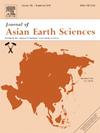泰国东部Klaeng断裂带演化中的多期构造变形:锆石U-Pb年龄和Hf同位素组成的约束
IF 2.7
3区 地球科学
Q2 GEOSCIENCES, MULTIDISCIPLINARY
引用次数: 0
摘要
克朗断裂带由中晚古生代碎屑沉积岩、糜棱质和中低变质岩、花岗岩和中生代红层砂岩组成。用锆石U-Pb定年分析了该带8块剪切花岗岩,确定了它们的年龄分别为448 Ma(晚奥陶世)、219 ~ 217 Ma(晚三叠世)和46.38 Ma(中始新世)。根据花岗岩年龄和构造分析,确定了D1-D4 4次变形事件。D1为三叠纪印支造山运动中东西向挤压形成的致密褶皱。D2为晚白垩世东西向转浅作用导致的红层开放褶皱和平缓倾角。D3显示在奥陶世和始新世花岗岩中观察到的自顶至东或左旋韧性剪切,发生在始新世中期。D4表现出右旋脆性剪切,重叠了早期的变形,与渐新世一些花岗岩的出土同时发生。D3和D4反映了与早期印度与欧亚大陆碰撞有关的大陆内走滑断裂。锆石Hf同位素表明,断裂带西缘奥陶系和三叠系花岗岩(εHf(T)−24.3 ~−3.5)来源于一个古老的、富集的地幔或地壳,表明其基底与冈瓦南—西布马苏地块有关。东缘始新世花岗岩为贫幔富壳混合源(εHf(T)−10.2 ~ + 6.8),与素可泰弧有关。因此,Klaeng断裂带大致位于两个地块的碰撞边界上,代表了泰国东部的古特提斯缝合带。本文章由计算机程序翻译,如有差异,请以英文原文为准。

Multiple phases of structural deformation in the evolution of the Klaeng fault zone, Eastern Thailand, constrained by zircon U–Pb ages and Hf isotopic compositions
The Klaeng fault zone comprises mid–late Palaeozoic clastic sedimentary rocks, mylonitic and low-to-medium-grade metamorphic rocks, granites, and Mesozoic redbed sandstones. Eight sheared granites from this zone were analysed using zircon U–Pb dating, confirming ages of 448 Ma (Late Ordovician), 219–217 Ma (Late Triassic), and 46.38 Ma (middle Eocene). This study identifies four deformation events (D1–D4) based on our granite ages and structural analyses. D1 is characterised by tight folds resulting from E–W compression during the Triassic Indosinian orogeny. D2 is defined by open folds and gentle dips in the redbeds due to Late Cretaceous E–W transpressional shortening. D3 demonstrates top-to-E or sinistral ductile shears observed in the Ordovician and Eocene granites, which occurred during the mid-Eocene. D4 exhibits dextral brittle shears that overprinted the earlier deformations, concurrent with the Oligocene exhumation of some granites. D3 and D4 reflect intra-continental strike-slip faulting related to the early collision of India with Eurasia. Zircon Hf isotopes indicate that the Ordovician and Triassic granites in the western margin of the fault zone derived from an ancient, enriched mantle or crust (εHf(T) − 24.3 to −3.5), suggesting a basement associated with the Gondwanan Sibumasu block. In contrast, the Eocene granite in the eastern margin originated from a mixed source of depleted mantle and enriched crust (εHf(T) −10.2 to + 6.8), indicating a basement related to the Sukhothai arc. Therefore, the Klaeng fault zone broadly lies along the collisional boundary between the two terranes, representing the Palaeotethys suture in Eastern Thailand.
求助全文
通过发布文献求助,成功后即可免费获取论文全文。
去求助
来源期刊

Journal of Asian Earth Sciences
地学-地球科学综合
CiteScore
5.90
自引率
10.00%
发文量
324
审稿时长
71 days
期刊介绍:
Journal of Asian Earth Sciences has an open access mirror journal Journal of Asian Earth Sciences: X, sharing the same aims and scope, editorial team, submission system and rigorous peer review.
The Journal of Asian Earth Sciences is an international interdisciplinary journal devoted to all aspects of research related to the solid Earth Sciences of Asia. The Journal publishes high quality, peer-reviewed scientific papers on the regional geology, tectonics, geochemistry and geophysics of Asia. It will be devoted primarily to research papers but short communications relating to new developments of broad interest, reviews and book reviews will also be included. Papers must have international appeal and should present work of more than local significance.
The scope includes deep processes of the Asian continent and its adjacent oceans; seismology and earthquakes; orogeny, magmatism, metamorphism and volcanism; growth, deformation and destruction of the Asian crust; crust-mantle interaction; evolution of life (early life, biostratigraphy, biogeography and mass-extinction); fluids, fluxes and reservoirs of mineral and energy resources; surface processes (weathering, erosion, transport and deposition of sediments) and resulting geomorphology; and the response of the Earth to global climate change as viewed within the Asian continent and surrounding oceans.
 求助内容:
求助内容: 应助结果提醒方式:
应助结果提醒方式:


